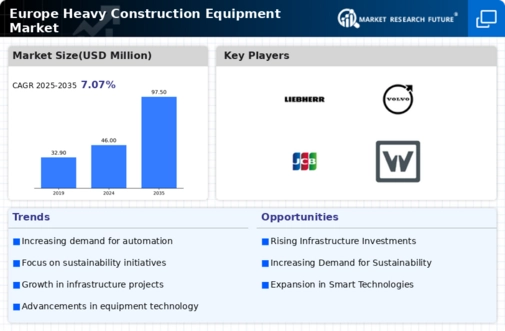Market Analysis
In-depth Analysis of Heavy Construction Equipment Market Industry Landscape
The Europe heavy construction equipment market is influenced by a myriad of factors that collectively shape its dynamics. One of the primary drivers of this market is the region's robust infrastructure development. As European countries continue to invest in modernizing and expanding their transportation networks, energy facilities, and urban spaces, the demand for heavy construction equipment remains consistently high. Government initiatives aimed at bolstering economic growth through infrastructure projects contribute significantly to the market's growth.
Moreover, the construction industry in Europe is experiencing a shift towards sustainable and technologically advanced practices. Stringent environmental regulations and a growing awareness of the need for eco-friendly construction solutions have led to an increased demand for construction equipment with enhanced fuel efficiency and reduced emissions. Manufacturers in the heavy construction equipment market are responding to this demand by incorporating innovative technologies, such as hybrid and electric systems, into their machinery.
The economic landscape also plays a crucial role in shaping the Europe heavy construction equipment market. Factors such as GDP growth, interest rates, and investment confidence influence the construction activities in the region. When the economy is thriving, there is usually an uptick in construction projects, resulting in higher demand for heavy construction equipment. On the contrary, economic downturns can lead to a slowdown in construction activities, impacting the market negatively.
Trade relationships and geopolitical factors also impact the heavy construction equipment market in Europe. Trade agreements and collaborations between European countries and other regions can affect the availability and pricing of raw materials and components used in manufacturing heavy construction equipment. Additionally, political stability or instability in certain regions can influence investment decisions, thereby impacting the overall market growth.
Technological advancements are another critical factor influencing the market. The adoption of digital technologies, such as Building Information Modeling (BIM) and telematics, is becoming increasingly prevalent in the construction industry. These technologies improve efficiency, reduce costs, and enhance overall project management. Heavy construction equipment manufacturers that incorporate these technologies into their products gain a competitive edge, as construction companies seek machinery that aligns with modern construction practices.
The European heavy construction equipment market is also responsive to demographic trends and urbanization. As the population in urban areas continues to grow, there is a corresponding increase in the demand for infrastructure and housing. This necessitates the use of heavy construction equipment for various construction projects, including residential and commercial developments.
Furthermore, the market is influenced by regulatory factors, including safety standards and emissions regulations. European governments often implement stringent regulations to ensure the safety of construction workers and mitigate the environmental impact of construction activities. Heavy construction equipment manufacturers need to comply with these regulations, which can impact the design, production, and cost of their machinery.
In conclusion, the Europe heavy construction equipment market is shaped by a complex interplay of factors ranging from economic conditions and technological advancements to regulatory requirements and demographic trends. The industry's ability to adapt to these influences and provide innovative, sustainable, and efficient solutions will determine its success in the dynamic European construction landscape.







Leave a Comment